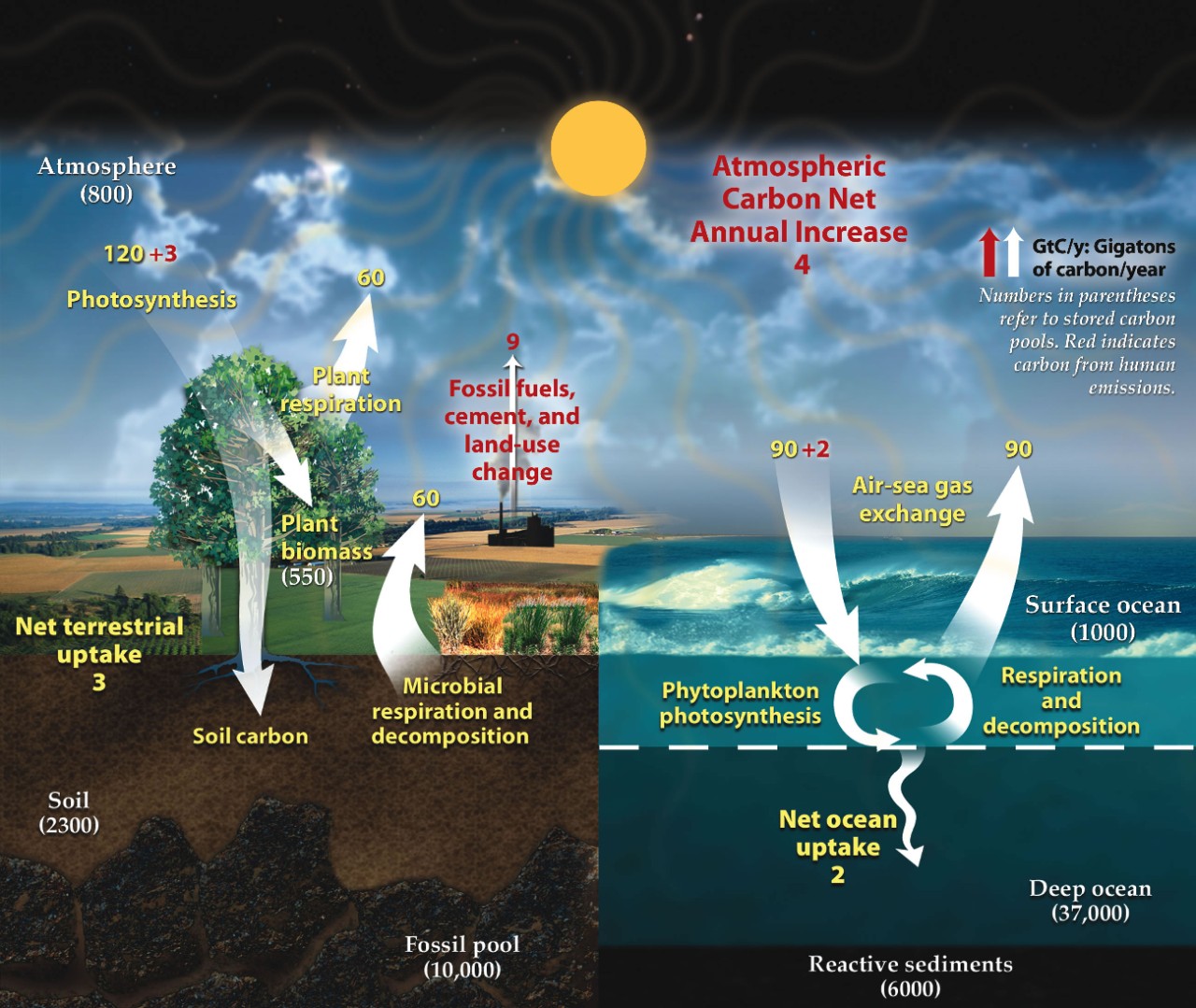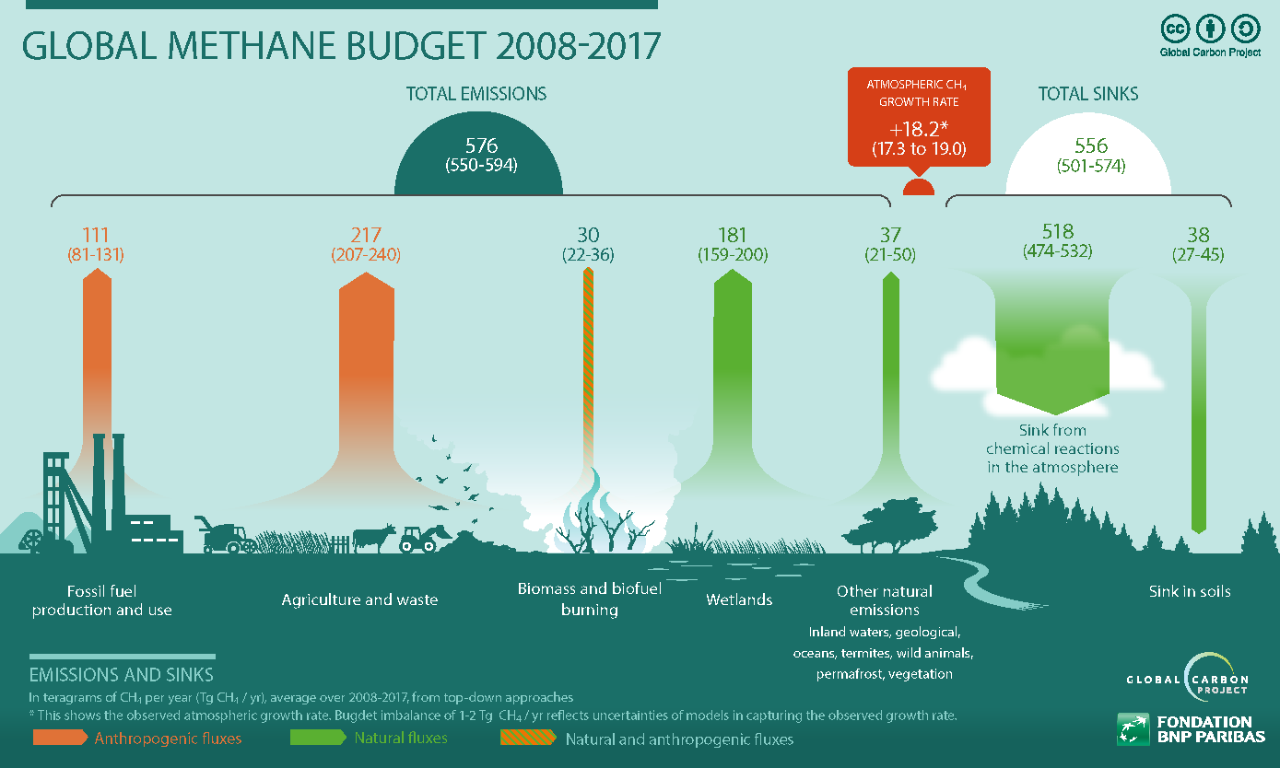Watching the Planet Breathe
For the first time, we will be able to watch as the western hemisphere breathes in and out every day, and to see the seasons change through the eyes of the biosphere. Equipped with these observations, scientists will better understand contributions to the carbon balance. These insights will help make robust predictions about Earth’s future.
With daily scans of landmasses in the western hemisphere, GeoCarb will provide an unprecedented number of high-quality measurements of carbon dioxide, methane, and carbon monoxide in the atmosphere. These observations, along with direct measurements of photosynthetic activity from SIF observations, will raise our understanding of the carbon cycle to a new level.
Carbon Cycle Overview
Carbon is a building block of life on our planet. It is stored in reservoirs on Earth – in rocks, plants and soil – in the oceans, and in the atmosphere. And it cycles constantly between these reservoirs. Understanding the carbon cycle is crucially important for many reasons. It provides us with energy, stored as fossil fuel. Carbon gases in the atmosphere help regulate Earth’s temperature and are essential to the growth of plants. Carbon passing from the atmosphere to the ocean supports photosynthesis of marine phytoplankton and the development of reefs. These processes and myriad others are all interwoven with Earth’s climate, but the manner in which the processes respond to variability and change in climate is not well-quantified.

Riebeek, Holli (16 June 2011). "The Carbon Cycle". Earth Observatory. NASA.
Carbon and Climate
In some years the biosphere takes more CO2 out of the atmosphere; in others it releases more to the atmosphere. We want to know more about what causes the year-to-year differences because that contains clues on how the carbon cycle works. For example, during the El Niño of 1997-1998, a sharp rise in CO2 was largely driven by fires in Indonesia. The most recent El Niño in 2015-2016 also led to a rise in CO2, but the cause was probably a complex mixture of effects across the tropics – including reduced photosynthesis in Amazonia, temperature-driven soil release of CO2 in Africa and fires in tropical Asia. These two examples of year-to-year variability in the carbon cycle, both globally and regionally, reflect what we now believe – namely, that variability is largely driven by terrestrial ecosystems. The ability to probe the climate-carbon interaction will require a much more quantitative understanding of the causes of this variability at the process level of various ecosystems.
Carbon Dioxide and Weather
The terrestrial biosphere exhibits both positive and negative feedbacks. The fact that the terrestrial biosphere is a greater net sink (or that it is a net sink at all) for CO2 emissions than the ocean, is a significant departure from what was thought a few decades ago. We also know that this terrestrial sink is highly variable (we have known about the variability for more than two decades), and there is significantly variability that appears to be tied to weather and climatic patterns and modes such as El Niño and La Niña.
Carbon dioxide
and methane are
heat-trapping
greenhouse gases.
Anthropogenic emissions of CO2 and CH4 are the primary forcing on the Earth's climate system, and the "unequivocal" cause of near-term changes to the Earth's climate.
Since 1750, the atmospheric concentration of CO2 has increased by almost 50% and methane has nearly tripled, after being relatively constant for more than 5000 years.
Uncertainty in causes of year-to-year variations in CO2 emissions translates to uncertainty in long-term responses of the carbon cycle to climate change.

GeoCarb's Role in Methane Observation
GeoCarb’s measurement of methane will be a crucial element in understanding the global carbon-climate system. Methane is produced by natural systems, such as wetlands, and by human activities such as natural gas production. We do not understand the methane portion of the carbon cycle as well as CO2. But just as with CO2, methane observations tell us a lot about the functioning of natural systems. Marshes release methane as part of the natural decay in the system. The rate of release is tied to how wet/dry and warm/cool the system is. It is uncertain how much natural gas production contributes to methane emissions. One reason to quantify these emissions more accurately is that they represent lost revenue for energy producers. The Environmental Protection Agency estimates a U.S. leakage rate of around 2 percent, which could add up to billions of dollars annually. We expect based on simulations that GeoCarb will produce maps that highlight the largest leaks with only a few days of observations. Finding leaks will reduce costs for energy producers and reduce the carbon footprint of natural gas. Currently, energy companies find leaks by sending personnel with detection equipment to suspected leak sites. Newer airborne sensors could make the process cheaper, but they are still deployed on a limited basis and in an ad hoc manner. GeoCarb’s regular observations will provide leakage information to producers in a timely manner to help them limit their losses.

Agriculture Collaboration
In collaboration with USDA National Institute of Food and Agriculture and the Foreign Agricultural Service, the data collected by GeoCarb will help develop models that can be applied to better understand global crop production. Less sensitive to cloud coverage, SIF measurements will allow GeoCarb to make daily maps that can deliver swift ecosystem health information on a continental scale.
Ecosystem Health
Solar Induced Fluorescence (SIF) is a phenomenon caused by plants reflecting excess sunlight off Earth’s surface and back into space. SIF is an indicator of photosynthesis and has shown a quick response to environmental stressors such as drought—therefore, SIF has become an important measure of ecosystem health.
Application Examples
Due to similar instrument specifications to OCO-2, the SIF products from the GeoCarb instrument - spectral range, spectral resolution and SNR - will have similar precision.
Click here for an example of the work our applications team completes on the GeoCarb project.